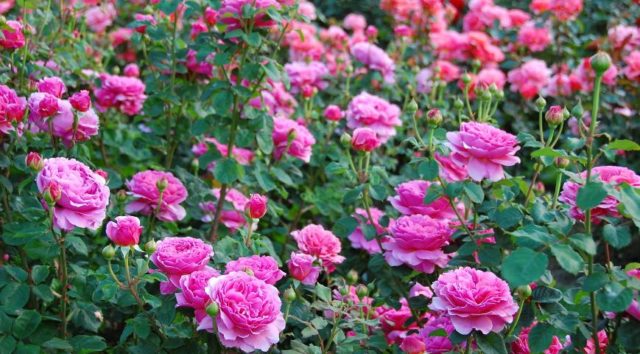Content
- 1 Breeding history
- 2 Description of the rose Princess Alexandra of Kent and characteristics
- 3 Advantages and disadvantages of the variety
- 4 Reproduction methods
- 5 Growing and care
- 6 Pests and diseases
- 7 Application in landscape design
- 8 Conclusion
- 9 Reviews with a photo about the rose Princess Alexandra of Kent
Rose Princess Alexandra of Kent received a varietal name after the monarch (a relative of Queen Elizabeth II). The lady was a great lover of flowers. The culture belongs to the elite English species. This variety is distinguished by large, densely doubled buds and the most delicate fruity aroma. The Rose Princess Alexandra of Kent has won many international awards and has been honored at the prestigious Glasgo 29 and Desert Rose Society Show.
Breeding history
Rose Princess Alexandra of Kent bred by breeder from the UK - David Austin. 2007 is considered the date of birth of a new culture. The flower grower decided to revive the old luxurious bush varieties, embodying their appearance in new hybrids, preserving a fresh aroma and sophisticated beauty. The manufacturer has registered the David Austin Roses brand in the UK. For varieties of English selection, dense double buds of an old shape are characteristic. Other names of the described culture: Ausmerchant, Princess Alexandra of Kent, Austin.
Description of the rose Princess Alexandra of Kent and characteristics
This is a short shrub, the length of the shoots of which does not exceed 60 cm. In the southern regions, they grow up to 1.5 m, where the rose is used as a climbing culture. The plant is compact, rounded, lush, about 70 cm wide.
Stems are long, strong, thickened, branched, densely covered with thorns. The leaves are small, characteristic of roses, dark green, glossy, densely cover the shoots.
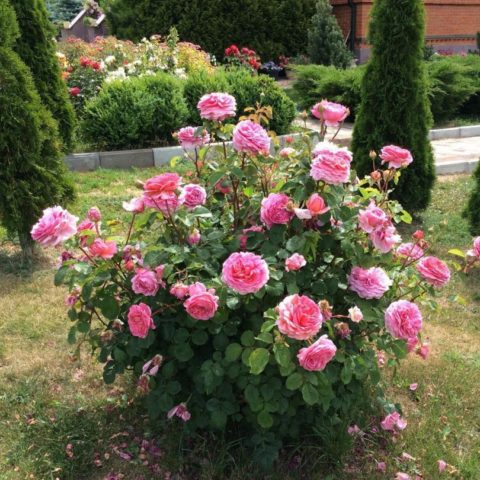
In the north, Princess Alexandra is a low-growing variety, in the south it grows up to 1.5 m
The flowers are large, up to 12 cm in diameter, rounded, densely double (number of petals 130), formed into a bowl-shaped rosette. There are many of them on the shoots, they grow in brushes. The color of the buds is intense pink with a warm undertone. The center of the flower is darker, along the edge of the petals are light. In late summer, they can turn creamy or peachy.
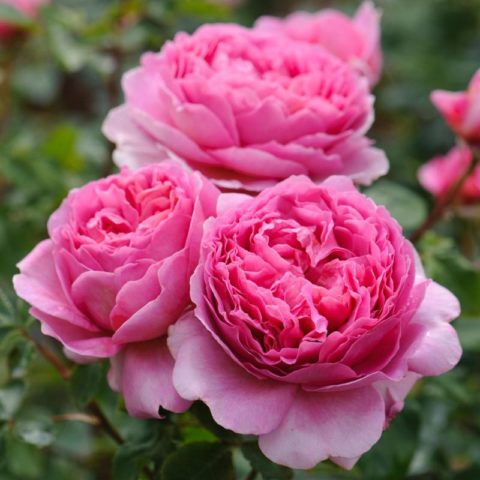
Each rose bud Princess Alexandra of Kent is filled with petals, there can be from 100 to 150 pieces
At the beginning of flowering, the fresh scent of the buds is similar to a tea rose, then it becomes lemon, you can also smell subtle notes of black currant. The process of ovary formation begins in June and lasts until the first frost.

Semi-open ovaries of the Princess Alexandra of Kent rose deep pink, later acquiring a peach, warm shade
The bloom is violent, continuous. Rose variety Princess Alexandra of Kent is frost-resistant, it can be grown in the northern regions of the country. The culture is immune to fungi: powdery mildew (ash), black spot. Also, the rose Princess Alexandra of Kent rarely suffers from slugs, ticks and aphids.
Advantages and disadvantages of the variety
There are practically no flaws in culture. The only negative is the exactingness of the soil composition and lighting.
Positive qualities of a rose:
- decorativeness;
- adaptability to climatic conditions;
- resistance to diseases, pests;
- Princess Alexandra of Kent has a delicate scent;
- fading, the buds do not lose their neatness, they tolerate rain well.
Rose bred by David Austin Princess Alexandra of Kent serves as a decoration for flower beds, park alleys, it can be grown as a climbing crop, it is also suitable for cutting.

In a vase after cutting, the Alexandra of Kent rose remains fresh for up to 10 days
Reproduction methods
The best way to breed the Princess Alexandra of Kent rose is to stock cuttings. The procedure is carried out after the first flowering. Cut off strong, not lignified stems, divide them into pieces of 10 cm. The cut is made at an angle of 45ᵒ, the lower leaves are removed, the upper ones are shortened by half.

Leaves are cut off to stop the moisture from evaporating from the stem.
The resulting cuttings are dipped in a root formation stimulator for a day. After the shoots are inserted into the soil at an angle, deepening by 2 cm.For planting, choose a loose fertile soil, a mixture of sand and peat, taken in equal quantities, is also suitable. Then the seedlings are watered, covered with glass jars or plastic cups. Plants are placed in a well-lit, warm place; direct sunlight should be avoided.
As the soil dries out, it is watered. The jar is removed for a few minutes, the plants are sprayed with a spray bottle.
In a month, the cuttings of the Princess Alexandra of Kent rose will have roots and leaves.
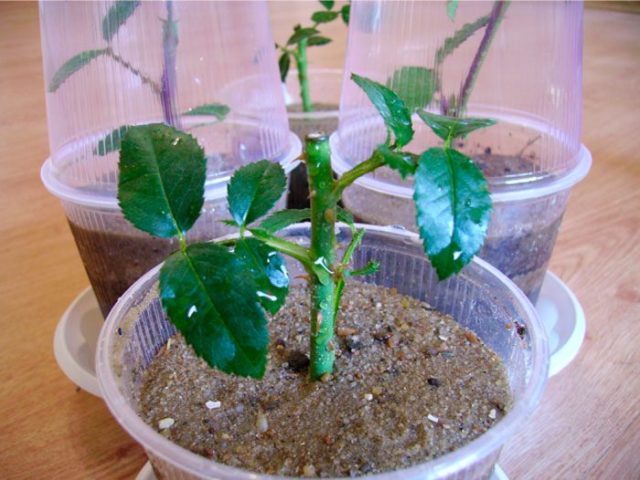
After the formation of true leaf plates, the plant is considered completely ready for planting.
During this period, the shelter in the form of a can is removed. Saplings are taken to the basement for the winter. In the spring they are ready for rooting outdoors.
Growing and care
For planting, a slightly shaded place is chosen: the English park rose Princess Alexandra of Kent does not tolerate direct sunlight. The bush is rooted for a long time, since the culture does not tolerate transplants. A flower bed with roses should be ventilated, but it is protected from drafts. It is also preferable to choose a height to avoid stagnant water at the roots.
To root a rose, Princess Alexandra of Kent needs a nutritious, sour and loose soil, black soil or loam is suitable. It is recommended to add humus to the depleted soil before planting.
Landing Algorithm:
- Dig a hole 0.7 m deep and 0.5 m wide.
- Put a layer of gravel or expanded clay on the bottom.
- Sprinkle the drainage with rotted compost.
- Make a small elevation from the garden soil.
- Lower the seedling into the hole, placing the root shoots along the slope of the earthen slide.
- Fill the hole with soil, deepening the root collar by 3 cm.
- Tamp the soil, shed abundantly.
The next day after planting, the soil is loosened, mulched, the weeds around are removed.
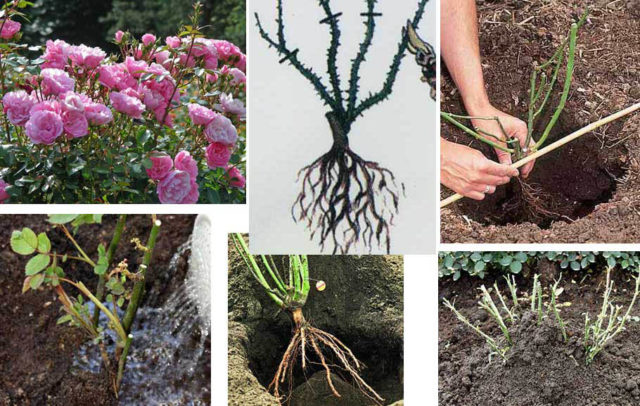
In the process of rooting, several rose bushes maintain a distance between them of at least 50 cm
Rose Princess Alexandra of Kent needs regular feeding. In the spring, liquid fertilizers with nitrogen are applied under the bush. During the flowering period, the culture needs phosphorus-potassium supplements.
The rose bush is watered as the earth dries up. Be sure to loosen the soil, remove weeds. Instead of these manipulations, you can mulch the soil around the rose.
In the spring, they carry out sanitary and rejuvenating pruning of the bush, in the fall - shaping. It is important to remove pest-affected or dried plant parts in a timely manner.
Before the onset of winter, the Princess Alexandra of Kent rose is spud with earth mixed with compost or humus. As soon as the air temperature drops below 0 ᵒС, the bush is covered with spruce branches, covered with a film on top, and the material is fixed.
Pests and diseases
Rose Princess Alexandra of Kent is resistant to diseases of flowering crops and garden pests. For prevention, the bush is regularly examined, especially in the spring and during the flowering period. At the first signs of damage by insects or fungi, the rose is treated with appropriate preparations, the affected parts of the plant are destroyed.
Application in landscape design
Rose Princess Alexandra of Kent is used for group plantings of 3-4 bushes in a flower bed. Such compositions are easy to perform and quite popular.
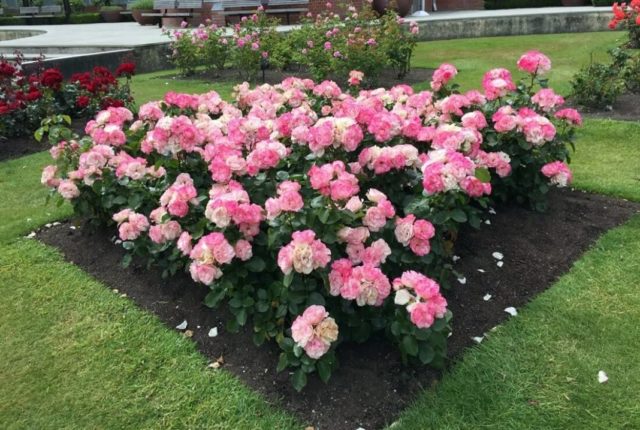
Monoclumba of roses does not need additional plantings, as it is beautiful in itself
Also, the culture organically fits into the design of the mixborder, the park area, it is used as a tapeworm or hedge. Near the luxuriously flowering shrub, inconspicuous plants and herbs are planted: catnip, lavender, salvia.
Conclusion
Rose Princess Alexandra of Kent is an English varietal crop that has received prestigious awards for its magnificent flowering and delicate bud aroma. The hybrid was bred on the basis of ancient species, which are distinguished by lush, thick double flowers. The culture has become widespread, thanks to its unpretentiousness, the ability to adapt to almost any climatic conditions.
Reviews with a photo about the rose Princess Alexandra of Kent


